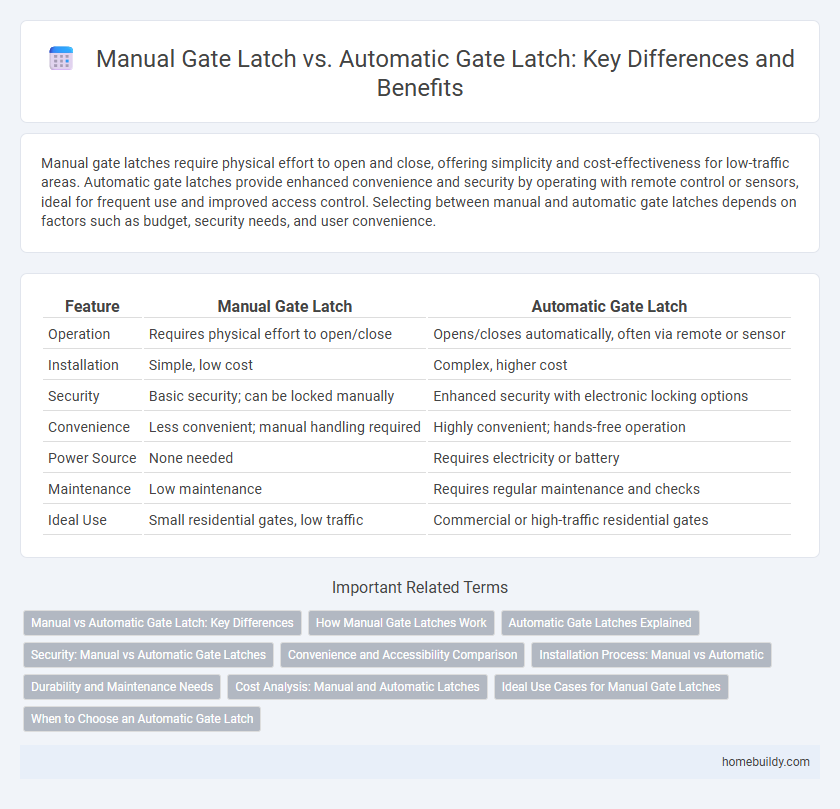Manual gate latches require physical effort to open and close, offering simplicity and cost-effectiveness for low-traffic areas. Automatic gate latches provide enhanced convenience and security by operating with remote control or sensors, ideal for frequent use and improved access control. Selecting between manual and automatic gate latches depends on factors such as budget, security needs, and user convenience.
Table of Comparison
| Feature | Manual Gate Latch | Automatic Gate Latch |
|---|---|---|
| Operation | Requires physical effort to open/close | Opens/closes automatically, often via remote or sensor |
| Installation | Simple, low cost | Complex, higher cost |
| Security | Basic security; can be locked manually | Enhanced security with electronic locking options |
| Convenience | Less convenient; manual handling required | Highly convenient; hands-free operation |
| Power Source | None needed | Requires electricity or battery |
| Maintenance | Low maintenance | Requires regular maintenance and checks |
| Ideal Use | Small residential gates, low traffic | Commercial or high-traffic residential gates |
Manual vs Automatic Gate Latch: Key Differences
Manual gate latches require physical effort to open and close, offering simplicity, durability, and cost-effectiveness, while automatic gate latches operate electronically or hydraulically, providing convenience, enhanced security, and remote access capabilities. Manual latches are less complex and easier to maintain but lack the smart features and integration options found in automatic systems. Choosing between them depends on factors such as security needs, budget, and the desired level of automation for gate management.
How Manual Gate Latches Work
Manual gate latches function by physically sliding or lifting a bar or bolt into a catch or strike plate to secure the gate, offering straightforward operation without the need for power or complex mechanisms. These latches rely on user interaction to lock or unlock the gate, making them ideal for areas without electrical access or where simplicity and reliability are prioritized. Common types include gravity latches, thumb latches, and slide bolts, which provide durable and cost-effective gate security solutions.
Automatic Gate Latches Explained
Automatic gate latches offer enhanced security and convenience by engaging and locking gates without manual effort, using mechanisms such as magnetic, hydraulic, or gravity-based systems. These latches improve safety for residential and commercial properties by ensuring gates close securely every time, reducing the risk of accidental openings or unauthorized access. Designed for durability and ease of installation, automatic gate latches often integrate with smart home systems for remote monitoring and control.
Security: Manual vs Automatic Gate Latches
Manual gate latches rely on physical locks or padlocks, requiring human intervention to secure the gate, which can pose risks if left unsecured or improperly locked. Automatic gate latches, often integrated with electronic locking mechanisms and sensors, provide enhanced security by enabling remote access control, real-time monitoring, and tamper alerts. These advanced systems reduce unauthorized entry risks and ensure gates remain securely closed without constant manual oversight.
Convenience and Accessibility Comparison
Manual gate latches require physical effort to open and close, which can be inconvenient for frequent use or for individuals with limited mobility. Automatic gate latches offer enhanced convenience by allowing remote operation, improving accessibility for all users, including those with disabilities or when carrying items. The choice between manual and automatic latches significantly impacts ease of access and overall user experience in gate management.
Installation Process: Manual vs Automatic
Manual gate latches typically involve a straightforward installation process, requiring basic tools and minimal adjustments, making them accessible for DIY projects. Automatic gate latches, however, demand a more complex setup that includes electrical wiring, sensor calibration, and sometimes professional assistance to ensure proper functionality and safety. The installation time for automatic latches is significantly longer due to these additional technical requirements.
Durability and Maintenance Needs
Manual gate latches are typically more durable due to their simple mechanical design, requiring minimal maintenance and fewer repairs over time. Automatic gate latches, while offering convenience, often contain electronic or motorized components that are more susceptible to wear and environmental damage, increasing the need for regular maintenance. Choosing between the two depends on the balance between long-term durability and the convenience of automated operation.
Cost Analysis: Manual and Automatic Latches
Manual gate latches generally cost between $10 and $50, making them a budget-friendly option with minimal installation expenses. Automatic gate latches range from $150 to over $600, depending on features like remote access, sensors, and power source requirements, leading to higher upfront and maintenance costs. Cost analysis should account for long-term benefits such as convenience and security, balanced against the initial investment and potential repair expenses associated with automatic models.
Ideal Use Cases for Manual Gate Latches
Manual gate latches are ideal for residential or low-traffic gates where simplicity and cost-effectiveness are prioritized. They provide reliable security without the need for electrical power, making them suitable for remote areas or gardens. Manual latches are also preferred in locations where occasional access control is sufficient, ensuring easy operation and low maintenance.
When to Choose an Automatic Gate Latch
Automatic gate latches are ideal for properties requiring enhanced security and convenience, such as high-traffic entrances or locations with frequent deliveries. Choose an automatic gate latch when consistent, hands-free operation is needed to prevent unauthorized access and ensure gates close securely without manual effort. These latches integrate well with electronic access control systems, providing remote control and monitoring capabilities.
manual gate latch vs automatic gate latch Infographic

 homebuildy.com
homebuildy.com